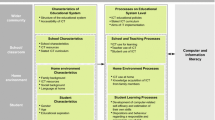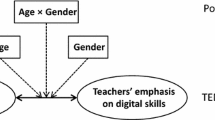Abstract
In Germany schools are obliged to foster students’ digital competences. Based on the proficiency levels of students’ computer and information literacy (CIL) from the International Computer and Information Literacy Study (ICILS 2013), and a theoretical approach to media education in school, this paper aims to provide evidence on the relevance of teacher- and school-related factors in the fostering of students’ CIL. On the basis of a representative sample of secondary school teachers in Germany a structural equation model (SEM) which accommodated the frequency of ICT-use in instruction as a mediator variable was computed. The results of the SEM indicate teachers’ attitudes towards the use of Information and Communication Technologies (ICT) in instruction, ICT-related collaboration, and sufficient ICT equipment at schools as significant predictors in fostering students’ CIL. Findings bear important implications for teacher education in terms of preparing teachers for this fundamental task.


Similar content being viewed by others
References
Ala-Mutka, K., Punie, Y., & Redecker, C. (2008). Digital competence for lifelong learning. In Policy brief. European Commission, Joint Research Centre: Institute for Prospective Technological Studies. http://ftp.jrc.es/EURdoc/JRC48708.TN.pdf accessed 1 February 2018.
Ananiadou, K., & Claro, M. (2009). 21st century skills and competences for new millennium learners in OECD countries (OECD Education Working Papers, No. 41). https://doi.org/10.1787/218525261154.
Anderson, R. (2008). Implications of the information and knowledge society for education. In J. Voogt, & G. Knezek (Eds.), International handbook of information technology in primary and secondary education (pp. 3–22). https://doi.org/10.1007/978-0-387-73315-9_1.
Anderson, R., & Ainley, J. (2010). Technology and learning: Access in schools around the world, in: B. McGaw, E. Baker, & P. Peterson (Eds.) International encyclopaedia of education. 3rd edition (pp. 21–33). Amsterdam, the Netherlands: Elsevier.
Angeli, C., & Valanides, N. (2009). Epistemological and methodological issues for the conceptualization, development, and assessment of ICT–TPCK: Advances in technological pedagogical content knowledge (TPCK). Computers & Education, 52, 154–168. https://doi.org/10.1016/j.compedu.2008.07.006.
Badia, A., Meneses, J., & Sigalés, C. (2013). Teachers’ perceptions of factors affecting the educational use of ICT in technology-rich classrooms. Electronic Journal of Research in Educational Psychology, 11(3), 787–808. https://doi.org/10.14204/ejrep.31.13053.
CEC [Commission of the European Communities]. (2007). Key competences for lifelong learning: European reference framework. Brussels: Directorate General Education and Culture. https://www.erasmusplus.org.uk/file/272/download accessed 1 February 2018.
Christensen, R., & Knezek, G. (2008). Self-report measures and findings for information technology attitudes and competencies. In J. Voogt & G. Knezek (Eds.), International handbook of information Technology in Primary and Secondary Education (pp. 349–365). New York: Springer Science + Business Media. https://doi.org/10.1007/978-0-387-73315-9_21.
Claro, M., Preiss, D., San Martín, E., Jara, I., Hinostroza, J., Valenzuela, S., Cortes, F., & Nussbaum, M. (2012). Assessment of 21st century ICT skills in Chile: Test design and results from high school level students. Computers & Education, 59(3), 1042–1053. https://doi.org/10.1016/j.compedu.2012.04.004.
Creemers, B. P. M., & Kyriakides, L. (2008). The dynamics of educational effectiveness. In A contribution to policy, practice and theory in contemporary schools. London, UK: Routledge.
Dexter, S., Seashore, K. R., & Anderson, R. E. (2002). Contributions of professional community to exemplary use of ICT. Journal of Computer Assisted Learning, 18(4), 489–497. https://doi.org/10.1046/j.0266-4909.2002.00260.
Drent, M., & Meelissen, M. (2008). Which factors obstruct or stimulate teacher educators to use ICT innovatively? Computers & Education, 51(1), 187–199. https://doi.org/10.1016/j.compedu.2007.05.001.
Drossel, K., Eickelmann, B., & Gerick, J. (2016). Predictors of teachers’ use of ICT in school – The relevance of school characteristics, teachers’ attitudes and teacher collaboration. Education for Information, 22(2), 551–573. https://doi.org/10.1007/s10639-016-9476-y.
Eickelmann, B. (2011). Supportive and hindering factors to a sustainable implementation of ICT in schools. Journal for Educational Research Online, 3(1), 75–103.
Eickelmann, B., & Schulz-Zander, R. (2008). Schuleffektivität, Schulentwicklung und digitale Medien. In W. Bos, H. G. Holtappels, H. Pfeiffer, H.-G. Rolff, & R. Schulz-Zander (Eds.), Jahrbuch der Schulentwicklung (Vol. 15, pp. 157–193). Weinheim, Germany: Juventa.
Endberg, M., Lorenz, R., & Senkbeil, M. (2015). Einstellungen von Lehrpersonen der Sekundarstufe I zum Einsatz digitaler Medien im Unterricht. In W. Bos, R. Lorenz, M. Endberg, H. Schaumburg, R. Schulz-Zander & M. Senkbeil (Eds.), Schule digital – der Länderindikator 2015. Vertiefende Analysen zur schulischen Nutzung digitaler Medien im Bundesländervergleich (pp. 95–140). Münster: Waxmann.
Ertmer, P. A. (2005). Teacher pedagogical beliefs: The final frontier in our quest for technology integration? Educational Technology Research and Development, 53(4), 25–39. https://doi.org/10.1007/BF02504683.
Ferrari, A. (2012). Digital competence in practice: An analysis of frameworks. Seville, Spain: Institute for Prospective Technological Studies, European Commission. http://www.ifap.ru/library/book522.pdf accessed 1 February 2018.
Ferrari, A. (2013). DIGCOMP: A framework for developing and understanding digital competence in Europe. Luxembourg: Publications Office of the European Union.
Fraillon, J., Schulz, W., & Ainley, J. (2013). International Computer and Information Literacy Study: Assessment Framework. https://doi.org/10.1007/978-3-319-14222-7
Fraillon, J., Ainley, J., Schulz, W., Friedman, T., & Gebhardt, E. (2014). Preparing for life in a digital age. The IEA International Computer and Information Literacy Study International Report: Springer. http://www.iea.nl/fileadmin/user_upload/Publications/Electronic_versions/ICILS_2013_International_Report.pdf accessed 1 February 2018.
Gräsel, C., Fußangel, K., & Pröbstel, C. (2006). Lehrkräfte zur Kooperation anregen – eine Aufgabe für Sisyphos? Zeitschrift für Pädagogik, 52(2), 205–219.
Hatlevik, O. (2009). How to identify and understand digital literacy among 9th grade norwegian students: examining the influences from school and home on students’ digital literacy. Digital Kompetanse, 4(3–4), 159–174.
Herring, M. C., Koehler, M. J., Mishra, P., Rosenberg, J., & Teske, J. (2016). Handbook of technological pedagogical content knowledge (TPACK) for educators. New York: Routledge.
Kline, R. B. (2011). Principles and practice of structural equation modeling (3rd ed.). New York: The Guilford Press.
KMK [Sekretariat der Ständigen Konferenz der Kultusminister der Länder in der Bundesrepublik Deutschland]. (2016). Bildung in der digitalen Welt. Strategie der Kultusministerkonferenz. https://www.kmk.org/fileadmin/Dateien/pdf/PresseUndAktuelles/2016/Bildung_digitale_Welt_Webversion.pdf (accessed 1 February 2018).
Kozma, R. (2003). Technology, innovation, and educational change: A global perspective. OR, ISTE: Eugene.
Kozma, R. (2008). Comparative Analyses of Policies for ICT in Education. In J. Voogt, & G. Knezek (Eds.), International Handbook of Information Technology in Education (pp. 1083–1096). https://doi.org/10.1007/978-0-387-73315-9_68.
Länderkonferenz MedienBildung. (2015). Kompetenzorientiertes Konzept für die schulische Medienbildung. LKM-Positionspapier Stand, 29(01), 2015. www.laenderkonferenz-medienbildung.de/index.php/medienbildung.html?file=files/Dateien_lkm/PDF/LKM-Positionspapier.pdf accessed 1 February 2018.
Law, N., & Chow, A. (2008). Teacher characteristics, contextual factors, and how these affect the pedagogical use of ICT. In N. Law, W. J. Pelgrum, & T. Plomp (Eds.), Pedagogy and ICT use in Schools around the World. Findings from the IEA-SITES 2006 (pp. 182–221). https://doi.org/10.1007/978-1-4020-8928-2_6
Law, N., Pelgrum, W., & Plomp, T. (2008). Pedagogy and ICT use in schools around the world: Findings from the IEA SITES 2006 study. Hong Kong SAR: Comparative Education Research Centre/Springer, University of Hong Kong. https://doi.org/10.1007/978-1-4020-8928-2.
Literat, I. (2014). Measuring new media literacies: Towards the development of a comprehensive assessment tool. Journal of Media Literacy Education, 6(1), 15–27.
Lorenz, R., & Endberg, M. (2015). Förderung der IT-bezogenen Fähigkeiten von Schülerinnen und Schülern durch Lehrpersonen in der Sekundarstufe I. In W. Bos, R. Lorenz, M. Endberg, H. Schaumburg, R. Schulz-Zander, & M. Senkbeil (Eds.), Schule digital – der Länderindikator 2015. Vertiefende Analysen zur schulischen Nutzung digitaler Medien im Bundesländervergleich (pp. 141–188). Münster: Waxmann.
Lorenz, R. & Endberg, M. (2016a). Förderung der medienbezogenen Kompetenzen von Schülerinnen und Schülern der Sekundarstufe I in Deutschland und im Bundesländervergleich. Aktuelle Ergebnisse für 2016 und der Trend seit 2015. In W. Bos, R. Lorenz, M. Endberg, B. Eickelmann, R. Kammerl & S. Welling (Hrsg.), Schule digital – der Länderindikator 2016. Kompetenzen von Lehrpersonen der Sekundarstufe I im Umgang mit digitalen Medien im Bundesländervergleich (S. 110–147). Münster: Waxmann.
Lorenz, R., & Endberg, M. (2016b). Zusammenhang zwischen medienbezogenen Lehrereinstellungen und der Förderung computer- und informationsbezogener Kompetenzen. In R. Strietholt, W. Bos, H.-G. Holtappels, & N. McElvany (Eds.), Jahrbuch der Schulentwicklung (Vol. 19, pp. 206–229). Weinheim: Beltz Juventa.
Lorenz, R., & Bos, W. (2017). Schule digital – der Länderindikator 2017. Theoretisches Rahmenmodell, Überblick über die Befunde des Länderindikators 2017 und Einordnung zentraler Ergebnisse der Erhebungszyk-len 2015, 2016 und 2017. In R. Lorenz, W. Bos, M. Endberg, B. Eickelmann, S. Grafe, & J. Vahrenhold (Eds.), Schule digital – der Länderindikator 2017. Schulische Medienbildung in der Sekundarstufe I im Bundesländervergleich und Trends von 2015 bis 2017 (pp. 11–35). Münster: Waxmann.
MCEECDYA [Ministerial Council on Education, Early Childhood Development and Youth Affairs]. (2010). National Assessment Program: ICT literacy years 6 & 10 report 2008. Carlton South, VIC, Australia: Curriculum Corporation. https://www.nap.edu.au/_resources/2008_NAP_ICTL_Public_Report.pdf accessed 1 February 2018.
MCEETYA [Ministerial Council on Education, Employment, Training and Youth Affairs]. (2007). National Assessment Program: ICT literacy years 6 and 10 report 2005. Carlton South, VIC, Australia: Curriculum Corporation. https://www.nap.edu.au/_resources/2005_ICTL_Public_Report_file_main.pdf accessed 1 February 2018.
Muthén, B. O. (2004). Latent variable analysis. Growth mixture modeling and related techniques for longitudinal data. In D. Kaplan (Ed.), The sage handbook of quantitative methodology (pp. 345–368). Thousand Oaks, CA: Sage.
Muthén, L. K., & Muthén, B. O. (1998-2017). Mplus User’s Guide (Eighth ed.). Los Angeles, CA: Muthén & Muthén.
P21 [Partnership for 21st Century Learning]. (2015). P21 Framework Definitions. http://www.p21.org/storage/documents/docs/P21_Framework_Definitions_New_Logo_2015.pdf (accessed 1 February 2018).
Pelgrum, W. J., Reinen, I. A. M. J., & Plomp, T. (1993). Schools, Teachers, Students and Computers: A Cross-national Perspective (IEA-COMPED Study, Stage 2). Enschede, the Netherlands: University of Twente.
Petko, D. (2012). Teachers’ pedagogical beliefs and their use of digital Media in Classrooms: Sharpening the focus of the ‘will, skill, tool’ model and integrating teachers’ constructivist orientations. Computers & Education, 58, 1351–1359. https://doi.org/10.1016/j.compedu.2011.12.013.
Sang, G., Valcke, M., van Braak, J., & Tondeur, J. (2010). Student teachers’ thinking processes and ICT integration: Predictors of prospective teaching behaviors with educational technology. Computers & Education, 54(1), 103–112. https://doi.org/10.1016/j.compedu.2009.07.010.
Scheerens, J. (1990). School Effectiveness and the Development of Process Indicators of School Functioning. In B. P. M. Creemers, T. Peters & D. Reynolds (eds), School Effectiveness and School Improvement (pp. 61–80). https://doi.org/10.1080/0924345900010106.
Scheerens, J. (2000). Improving school effectiveness. Paris, France: UNESCO, International Institute for Educational Planning.
Scherer, R., Siddiq, F., & Teo, T. (2015). Becoming more specific: Measuring and modeling Teachers' perceived usefulness of ICT in the context of teaching and learning. Computers & Education, 88, 202–214. https://doi.org/10.1016/j.compedu.2015.05.005.
Siddiq, F., Scherer, R., & Tondeur, J. (2016). Teachers' emphasis on developing Students' digital information and communication skills (TEDDICS): A new construct in 21st century education. Computers & Education, 92, 1–14. https://doi.org/10.1016/j.compedu.2015.10.006, 14.
Tavakol, M., & Dennick, R. (2011). Making sense of Cronbach’s alpha. International Journal of Medical Education, 2, 53–55. https://doi.org/10.5116/ijme.4dfb.8dfd.
ten Brummelhuis, A., & Kuiper, E. (2008). Driving Forces for ICT in Learning. In J. Voogt, & G. Knezek (eds.), International Handbook of Information Technology in Primary and Secondary Education (pp. 97–111). https://doi.org/10.1007/978-0-387-73315-9_6.
Tondeur, J., Hermans, R., van Braak, J., & Valcke, M. (2008). Exploring the link between teachers’ educational belief profiles and different types of computer use in the classroom. Computers in Human Behavior, 65(3), 555–575. https://doi.org/10.1016/j.chb.2008.02.020.
Tondeur, J., van Braak, J., Ertmer, P. A., & Ottenbreit-Leftwich, A. (2016). Understanding the relationship between Teachers' pedagogical beliefs and technology use in education: A systematic review of qualitative evidence. Educational Technology Research and Development, 65, 555–575. https://doi.org/10.1007/s11423-016-9481-2.
Voogt, J., Erstad, O., Dede, C., & Mishra, P. (2013). Challenges to learning and schooling in the digital networked world of the 21st century. Journal of Computer Assisted Learning, 29(5), 403–413. https://doi.org/10.1111/jcal.12029.
Wang, J., & Wang, X. (2012). Structural equation modeling. Applications Using Mplus. West Sussex, UK: Wiley.
Welling, S., Lorenz, R,. & Eickelmann, B. (2016). Kooperation von Lehrkräften der Sekundarstufe I zum Einsatz digitaler Medien in Lehr- und Lernprozessen in Deutschland und im Bundesländervergleich. In W. Bos, R. Lorenz, M. Endberg, B. Eickelmann, R. Kammerl, & S. Welling (Eds.), Schule digital – der Länderindikator 2016. Kompetenzen von Lehrpersonen der Sekundarstufe I im Umgang mit digitalen Medien im Bundesländervergleich (pp. 236–263). Münster: Waxmann.
Acknowledgements
The presented study was made possible by the German foundation Deutsche Telekom Stiftung.
Author information
Authors and Affiliations
Corresponding author
Additional information
Publisher’s Note
Springer Nature remains neutral with regard to jurisdictional claims in published maps and institutional affiliations.
Rights and permissions
About this article
Cite this article
Lorenz, R., Endberg, M. & Bos, W. Predictors of fostering students’ computer and information literacy – analysis based on a representative sample of secondary school teachers in Germany. Educ Inf Technol 24, 911–928 (2019). https://doi.org/10.1007/s10639-018-9809-0
Received:
Accepted:
Published:
Issue Date:
DOI: https://doi.org/10.1007/s10639-018-9809-0




